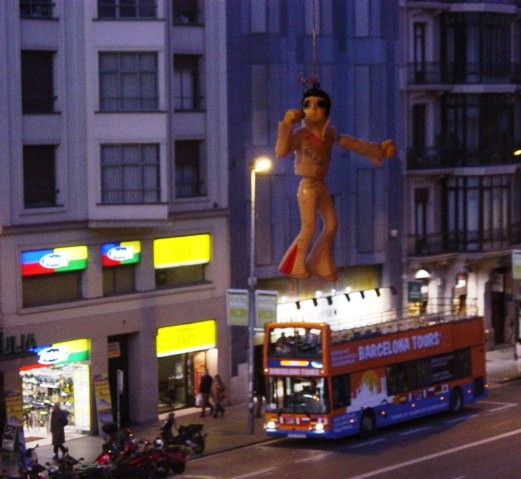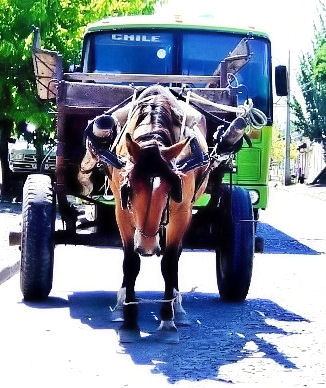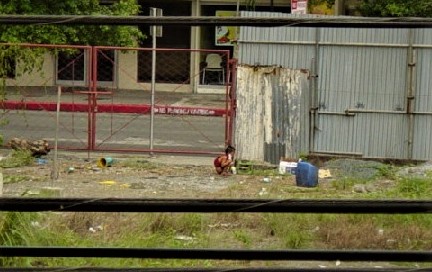Low hanging lights illuminated the small, dark arena. The wooden bleachers were full to bursting with unsavory characters yelling a continuous stream of unintelligible words punctuated by intimidating hand gestures. Anyone not carrying a knife, and willing to use it, was asking to be relieved of all his money. Bets were made and welched on. The welchers were brutally murdered while the crowd approvingly watched. “He should have known better than to make a bet he couldn’t keep,” their inaction said. A drug kingpin and his cronies, automatic rifles in tow, weaved their way through and under the bleachers in search of our hero. In between the screaming and death, a cockfight, Hollywood style, was taking place.
The Hollywood image of a Southeast Asian cockfight was, more-or-less, what I expected to find at the cockpit in the Pampanga province of the Philippines. A recent murder in a cockpit in the southern Philippines hadn’t done much to improve their image. The criminal New Peoples’ Army had carried out the murder, against a former member, and no one else had been injured. The murder, I reasoned, could have happened anywhere, it just happened to be at a cockpit. It still added to the anxiety I was feeling as we walked through the gate and onto the grounds of the arena.
The area within the fences, but outside the arena, was cluttered with roosters randomly placed in green holding cages. Two large, covered holding areas were also on the grounds. In all, hundreds of roosters were waiting for their turn in the pit.
The arena itself was similar enough to the Hollywood depiction. A five-foot tall concrete square, with sides 12 feet long, emerged from the center of the tiny stadium. Plexiglas surrounded the cockpit. An enormous tin light fixture, hanging by ropes extending from the ceiling, dangled precariously over the cockpit. Untreated wooden bleachers stretched at a steep angle towards the ceiling. Large fans were blowing on the crowd, providing relief from the stifling heat. The arena walls began high off the ground, just beneath the level of the highest bleacher row. The wooden walls protected the spectators, the overwhelming majority of which were male, from the sun but still allowed a breeze to enter. The walls ended three feet from the ceiling to allow natural light to enter the building. The tin roof provided protection from the searing summer sun.
My tensions were somewhat allayed when I entered the arena to find the crowd laughing hysterically at the two roosters in the pit that were refusing to fight. They looked more like two lovers on the dance floor than bloodthirsty killers. Even with large amounts of money riding on the outcome of the fight, the Filipino, good-natured approach to life was on display.
The roosters eventually staged the battle to the death upon which everyone was waiting. When the referee declared a winner, money began flying throughout the arena, literally flying. It is common for a person to place bets with multiple people for each fight. Wagers are often made with individuals across the cozy arena. At the conclusion of a fight, rather than walk to each person to whom a debt is owed, the money is crumpled up into a ball and thrown to that person. If the money misses its mark, someone nearby will help it find its rightful owner. Honesty and integrity are not taken lightly in the cockpit. Bets are made and honored. Anyone attempting to weasel out of a loosing wager is likely to meet a Hollywood ending.
After the battle of the dancing roosters was finished, and the ring had been swept clear of feathers, the next two contestants, accompanied by their owners, entered the ring. The owners initially moved to their respective corners, which were marked by a painted semicircle. After a very brief pause, the roosters were brought to the fighting circle where they were poked into each other and allowed to take running starts at their future opponent before being snatched back by their tails of which the owners had never relinquished a grasp. All of this was done to make the roosters angry at each other and to give the betting public something upon which to base their wagers.
The emcee, while the roosters were pretend pitted against each other, led another man around the ring by the arm. The gentleman being led was accepting bets with the house; recording them by scribbling into a notepad. The emcee and the scribe made two laps around the ring before announcing that the official wagering had concluded.
A tremendous burst of noise greeted the announcement. Suddenly three quarters of the arena was standing, shouting, hissing, making kissing noises and gesticulating. The unofficial betting had begun. Spectator to spectator wagering at a cockfight is noisy, complicated and a thing of beauty.
The process begins with the arena indicating which of the roosters will be the basis for all bets. This is done by illuminating one of the lamps that are placed in the corners of the fighters. The lamps indicate if the rooster fighting from that corner is the Mayroon (red) or Wala (white) rooster. The Mayroon or Wala designation does not pertain to the actual color of the chicken, but rather is a designated color for the corner.
Placing bets is accomplished through an extremely complicated body language ritual. The initial step is making eye contact with a potential partner. Hissing, kissing and clapping sounds are used to get peoples attention; although, with an arena full of people making the same noises, I’m not sure how one distinguishes him/herself. The sounds become louder and more frantic closer to fight time as those who have yet to wager their desired amount of money try desperately to attract a suitor.
After eye contact has been made, an offer of odds is made using hand gestures. A person may choose to ignore the offer, counter-offer odds or accept the offer. After the odds are agreed, another series of hand gestures are used to agree the amount of the bet. The wager is final when one of the parties indicates that the odds and amount are acceptable.
The most common way to accept a bet is to turn away from the person and to move the back of the hand towards that person, beginning with the palm facing the acceptors face and concluding, after a sweeping motion, with the palm in the direction of the accepted. The move strongly resembles the ‘shoo away’ motion of Western cultures.
After a few minutes of shouting and wagering, another announcement was made and the spectators were once again seated calmly. The fight was about to begin.
Cases made of bone, used to cover the razor blade tied to the roosters’ legs, were removed from each bird before they were placed in the center of the ring. For a brief moment, the official held the birds by the back of their necks so that they were facing each other but not touching, before releasing them onto each other.
The majority of the crowd remained seated and surprisingly calm as the fights took place. In the ring, the roosters pecked, flew over each other and flailed their legs as they attempted to gain control of the battle. At any pause in the action, the official grabbed the roosters by the necks, faced them off and set them free to fight again.
The battles didn’t last long. A couple of minutes were usually all that was required before one of the prizefighters was on the way to his owner’s dinner table. To confirm that the loosing rooster was no longer alive, a few vain attempts would be made by the official to stand up the bird before the fight was ended. There is no mercy rule in cockfighting. The fight doesn’t end until one of the roosters is indisputably dead. With the amount of money wagered on the birds, it’s hard to imagine that anyone in the crowd would allow the official to use his judgment in deciding that one of the birds had had enough.
The bird battles continued for several hours, but I lost interest after the first thirty minutes. Watching the spectators was, to me, much more enjoyable than watching the poultry pugilists. I was later informed that many of the spectators were members of the New Peoples’ Army. I may have kept my eyes to myself more if I had known that at the time.
As we were leaving the grounds, I asked a gentleman who attends the cockfights at least once a week if he would watch them if there was no wagering. “Nah,” he said without a moment of hesitation, “that would be boring.”


